S
Suzanne Scacca
Guest
As you look for ways to create a better experience for your customers online, it’s important to think about what they need and where they should be when they get it. This goes beyond the matter of mobile vs. desktop. This is about choosing the right platforms and channels and designing a seamless experience around and between them.
There was a time not too long ago when it wasn’t uncommon for people to question whether they should build a website or a mobile app for their business. In some niches, the question was whether or not they even needed a website or if they could just get away with using Facebook.
But in 2020 and beyond, we can’t afford to entertain ideas like that anymore.
Today, we’re going to explore some ways that businesses are using cross-platform strategies. We’re also going to look at why it’s important to create unique experiences for each instead of duplicating the experience from device to device, platform to platform.
Designing Cross-Platform Digital Experiences
On average, Americans spend about 6.5 hours with digital media every day:
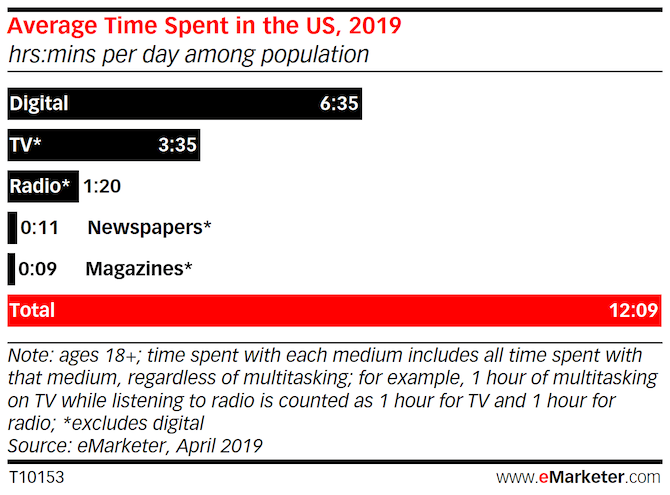
More often than not, these digital experiences take place across multiple devices. According to Think with Google data, 57% of users freely switch between devices every day:

About a quarter of users (or less) stick to one device.
But it’s not just multiple devices we have to account for either. We have to consider what kinds of digital experiences are best for each of those devices and why.
Below, we’re going to look at a number of brands that have successfully built out digital experiences across a diverse set of platforms and how each of them contributes to a better whole.
Murdoch University’s Virtual Recruitment Strategy
Educational institutions like universities and colleges really don’t have a choice when it comes to using a cross-platform approach. The majority of their target audience is Generation Z, which means catering to a group that is extra confident and comfortable with technology.
So, let’s look at how Murdoch University has handled this.
Desktop Website
This is the homepage of the website:

It’s engaging and to the point, which ensures that interested students can quickly get to the information about studying there. The rest of the site has been streamlined for that same effect.
Mobile Website
The second element in the cross-platform strategy is the fully responsive website—a must-have when appealing to the 97% of Gen Z who own smartphones.
Originally, the Murdoch University website was built in 2007, so its original build wouldn’t have been able to serve the modern-day smartphone user. In 2016, however, their site was completely overhauled and, with it, came a responsive mobile site.

Notice the difference between this design and desktop. For starters, the hero banner isn’t static. It’s a news bulletin-style slider, which works well for research-hungry mobile users.
Also notice how the header and navigation live in the bottom of the site. Considering how many Gen Z users have smartphones, this is a wise choice as navigation and search are within easier reach of the thumb zone.
Virtual Campus Tour
The virtual campus tour is an augmented reality experience that gives students the chance to explore campus before scheduling an in-person tour or spending time filling out an application. It feels a lot like "walking" down the street in Google Maps:

A platform like this might not make sense for an organization that targets a wider range of people since not everyone "gets" AR. However, Gen Z will and it’ll go a long way in their decision-making process.
Virgin Active UK’s Full-service Customer Solution
Brick-and-mortar businesses can’t afford to rely solely on customer-facing experiences that take place on-site or over the phone or email. Customers expect you to make it easy for them to:
Virgin Active UK, for instance, is a company that’s done this well. It’s created a cohesive and consistent experience from platform to platform.
The Website
Virgin Active is a global health club. But like other multi-location organizations, it’s created individual digital properties to represent its various hubs.
As you can see here, the UK website alone provides an end-to-end solution for the customer.
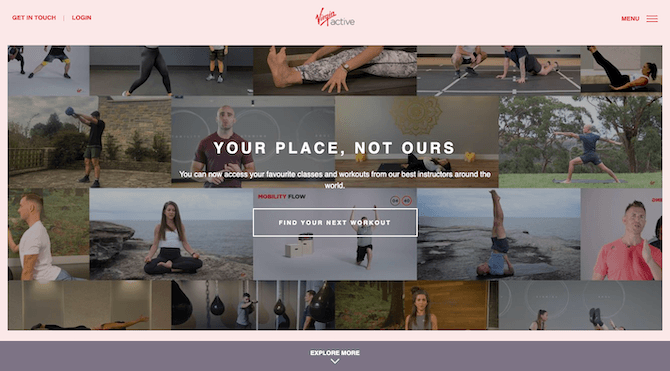
The first thing the responsive Virgin Active website does is serve as a place to attract, educate, and convert leads into club members. And it does that through relatable fitness imagery and encouraging messaging.
The second thing it does is serve as a place for existing customers to log in and manage their accounts. They can do that once they’ve started a membership through the Join portal:
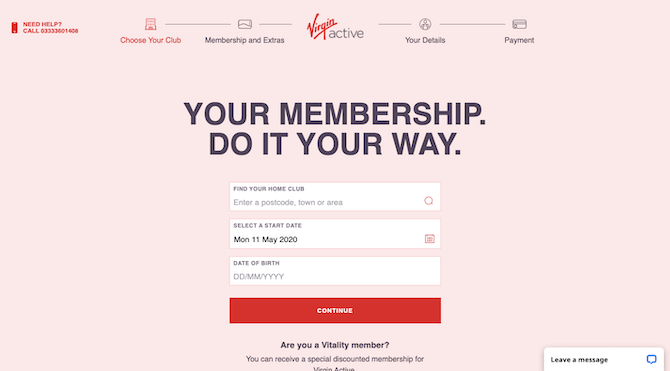
The intake process is easy to complete—that goes for both desktop and mobile.
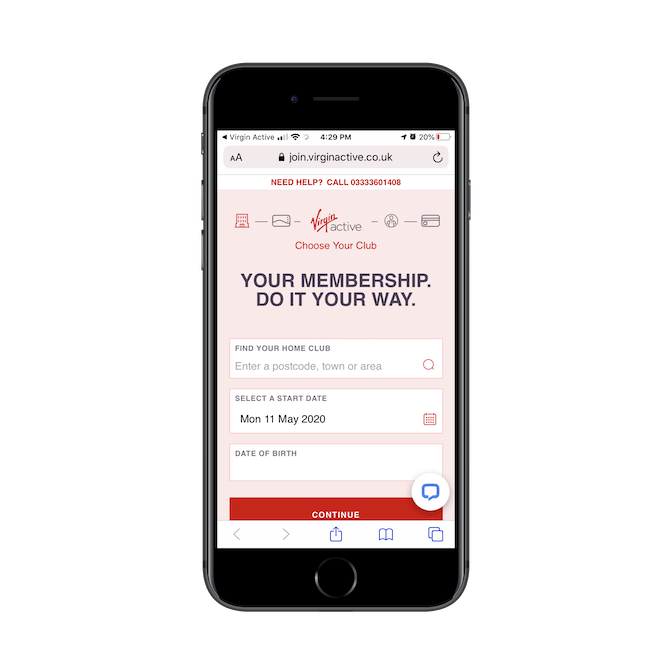
Considering how important the mobile website will be for smartphone-using club members, it needs to be able to keep up with desktop every step of the way (which it does).
Mobile App
Virgin Active members have their choice of account access—through the Login area on the website or through the mobile app. But they need to first sign up through the site.
Before directing them to the membership login page, the app will help the customer find a home location first.
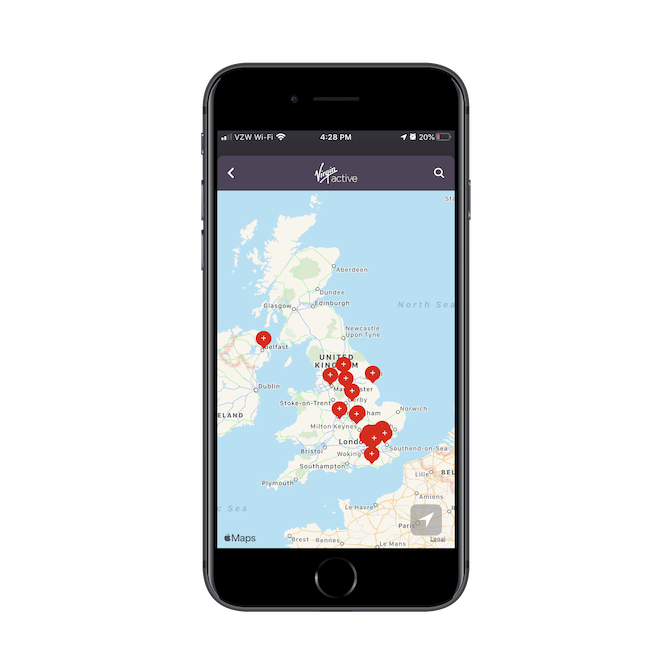
Once they’ve selected a location, they’ll get details on site hours, address, and amenities. When they’re ready to get started, the app seamlessly transitions them to their mobile browser to complete the signup process. They can return to the app and start managing their membership.
The app itself (as well as the membership portal through the site) is a very useful tool. It takes the digital customer experience to a whole new level. With the app, members can:
According to Twitter, 85% of its SMB users believe that it’s an important platform for providing support to customers. Do you know why that is?
Take email, for instance. There’s a chance that support requests will get lost in someone’s overloaded inbox or get marked as spam. Calling a company might be an option, but with labyrinth-like routing systems and long wait times, customers might not like that one either.
Social media—and Twitter, in particular—is a great platform for this and it’s one that Virgin Active has taken advantage of to provide support.
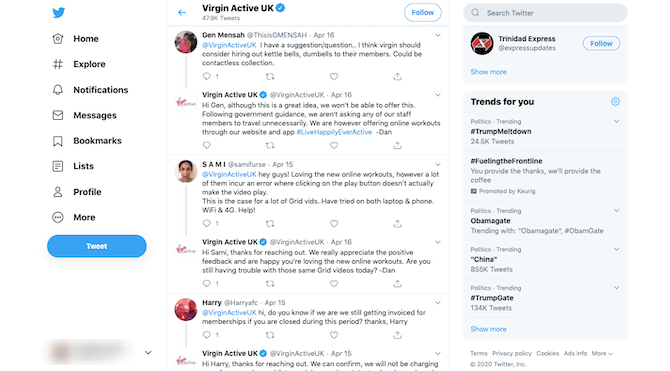
Businesses are already on social media every day, so someone’s going to catch any customer service requests that come through and in a timely manner, at that. Plus, it’s a public forum, so if someone puts a piece of feedback or question out there, others are going to see it. Businesses can’t ignore those kinds of conversations and customers know it.
Teknion’s Multi-Layered Ecommerce Experience
Retailers have experienced some extraordinary changes over the past couple of decades.
The introduction of the Internet opened retailers up to a new way to get inventory in front of customers. The smartphone changed the way people shop, with their phones often serving as a companion to the online and in-store shopping experiences. And social media has proven to be a useful platform not just for marketing one’s products, but actually selling them, too.
Teknion, a global furniture company, has made use of all these technologies… and more.
The Website
One of the frustrating things about shopping online is finding a product you really love, only to discover it’s not available in your country. Country and language switchers help with this on a website as can dedicated subdomains for each location. Teknion does both of these things.
It also has customized navigations based on where shoppers are. For example, this is a comparison of its menu for shoppers in Canada (left) and shoppers in Africa (right).

Again, this removes the frustration and friction from the shopping experience since customers only see the items that are the most relevant and available to them.
The 3D Warehouse
At the bottom of the Teknion website, shoppers will find a lengthy string of what appear to be social media icons.

The latter half of the list, however, are third-party platforms that provide more insight into its inventory. One of those links (the one to the left of the capital "A") goes to 3D Warehouse.
It’s here that shoppers get access to Teknion’s 3D interactive planning tool.
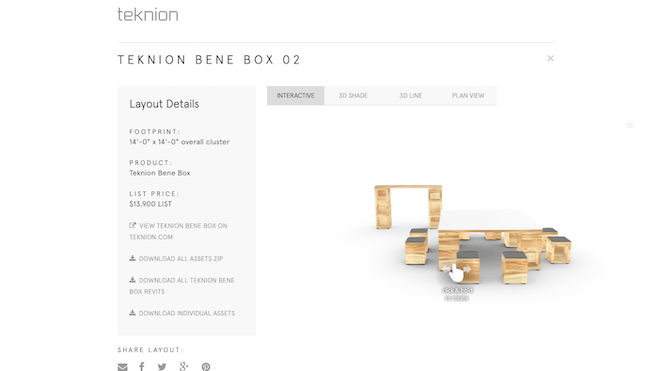
This tool lets shoppers take a closer look at Teknion’s product line, viewing each piece from different angles as well as previewing the furniture layout and dimensions. As VR and AR become more widely accepted by consumers, this kind of tool is the perfect complement to the traditional online shopping experience. And a great way to stand above the competition.
The Store
The Teknion website basically serves as a digital showroom for its physical showroom. However, customers don’t have to go to the store to buy furniture from them. They can shop online at the Teknion Store.
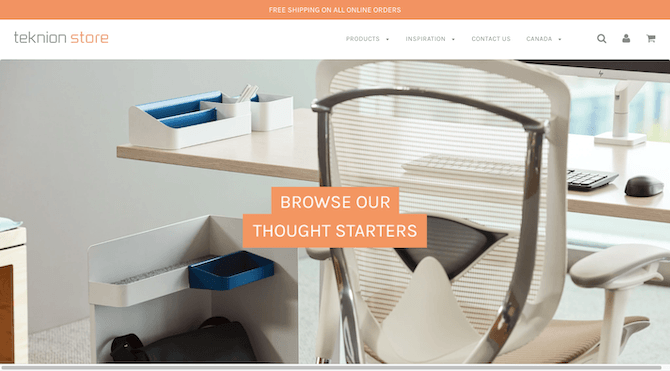
This is much more of a traditional ecommerce store layout than the Teknion website, so shoppers can easily breeze through this site and pick up what they want when they’re ready.
Instagram Shopping
The shopping experience doesn’t stop there. Teknion also recognizes the power of Instagram as an ecommerce tool.

This link and promotional page let website shoppers know Instagram provides more than just the same ol’ photos they’d find on the site. They can see their furniture in real life scenarios.
By including this on the site, it’s also subtle way to say, "Hey, follow us on Instagram so you can see more of what we have."
According to a Facebook IQ study, Instagram shopping is a valuable feature for shoppers with many of them using it to:

So, it’s smart of Teknion to add this to its set of ecommerce platforms.
Wrap-Up
As you can see, it isn’t enough to build a single digital platform to reach your users. Instead, you need to focus on designing experiences on a much grander scale, with various platforms catering to specific purposes while seamlessly integrating with one another.
This means you’ll need a better understanding of which devices your users are on and which channels they’re most likely to engage with you through. Once you have this data, you can start crafting cross-platform experiences they’ll enjoy.
Continue reading...
There was a time not too long ago when it wasn’t uncommon for people to question whether they should build a website or a mobile app for their business. In some niches, the question was whether or not they even needed a website or if they could just get away with using Facebook.
But in 2020 and beyond, we can’t afford to entertain ideas like that anymore.
Today, we’re going to explore some ways that businesses are using cross-platform strategies. We’re also going to look at why it’s important to create unique experiences for each instead of duplicating the experience from device to device, platform to platform.
Designing Cross-Platform Digital Experiences
On average, Americans spend about 6.5 hours with digital media every day:

More often than not, these digital experiences take place across multiple devices. According to Think with Google data, 57% of users freely switch between devices every day:

About a quarter of users (or less) stick to one device.
But it’s not just multiple devices we have to account for either. We have to consider what kinds of digital experiences are best for each of those devices and why.
Below, we’re going to look at a number of brands that have successfully built out digital experiences across a diverse set of platforms and how each of them contributes to a better whole.
Murdoch University’s Virtual Recruitment Strategy
Educational institutions like universities and colleges really don’t have a choice when it comes to using a cross-platform approach. The majority of their target audience is Generation Z, which means catering to a group that is extra confident and comfortable with technology.
So, let’s look at how Murdoch University has handled this.
Desktop Website
This is the homepage of the website:

It’s engaging and to the point, which ensures that interested students can quickly get to the information about studying there. The rest of the site has been streamlined for that same effect.
Mobile Website
The second element in the cross-platform strategy is the fully responsive website—a must-have when appealing to the 97% of Gen Z who own smartphones.
Originally, the Murdoch University website was built in 2007, so its original build wouldn’t have been able to serve the modern-day smartphone user. In 2016, however, their site was completely overhauled and, with it, came a responsive mobile site.

Notice the difference between this design and desktop. For starters, the hero banner isn’t static. It’s a news bulletin-style slider, which works well for research-hungry mobile users.
Also notice how the header and navigation live in the bottom of the site. Considering how many Gen Z users have smartphones, this is a wise choice as navigation and search are within easier reach of the thumb zone.
Virtual Campus Tour
The virtual campus tour is an augmented reality experience that gives students the chance to explore campus before scheduling an in-person tour or spending time filling out an application. It feels a lot like "walking" down the street in Google Maps:

A platform like this might not make sense for an organization that targets a wider range of people since not everyone "gets" AR. However, Gen Z will and it’ll go a long way in their decision-making process.
Virgin Active UK’s Full-service Customer Solution
Brick-and-mortar businesses can’t afford to rely solely on customer-facing experiences that take place on-site or over the phone or email. Customers expect you to make it easy for them to:
- Research your business before signing up or buying anything
- Sign up online rather than have to fill out a form in person
- Manage their accounts without having to contact someone to do it for them
- Reach customer support through the channels they’re already on
- And so on
Virgin Active UK, for instance, is a company that’s done this well. It’s created a cohesive and consistent experience from platform to platform.
The Website
Virgin Active is a global health club. But like other multi-location organizations, it’s created individual digital properties to represent its various hubs.
As you can see here, the UK website alone provides an end-to-end solution for the customer.

The first thing the responsive Virgin Active website does is serve as a place to attract, educate, and convert leads into club members. And it does that through relatable fitness imagery and encouraging messaging.
The second thing it does is serve as a place for existing customers to log in and manage their accounts. They can do that once they’ve started a membership through the Join portal:

The intake process is easy to complete—that goes for both desktop and mobile.

Considering how important the mobile website will be for smartphone-using club members, it needs to be able to keep up with desktop every step of the way (which it does).
Mobile App
Virgin Active members have their choice of account access—through the Login area on the website or through the mobile app. But they need to first sign up through the site.
Before directing them to the membership login page, the app will help the customer find a home location first.

Once they’ve selected a location, they’ll get details on site hours, address, and amenities. When they’re ready to get started, the app seamlessly transitions them to their mobile browser to complete the signup process. They can return to the app and start managing their membership.
The app itself (as well as the membership portal through the site) is a very useful tool. It takes the digital customer experience to a whole new level. With the app, members can:
- Manage their profile and membership details
- Find, book, and cancel classes
- Automatically add classes to their device’s calendar with a built-in reminder
- Use guest passes
- Get rewarded for referring others to the club
- Link to Boditrax to track their progress
According to Twitter, 85% of its SMB users believe that it’s an important platform for providing support to customers. Do you know why that is?
Take email, for instance. There’s a chance that support requests will get lost in someone’s overloaded inbox or get marked as spam. Calling a company might be an option, but with labyrinth-like routing systems and long wait times, customers might not like that one either.
Social media—and Twitter, in particular—is a great platform for this and it’s one that Virgin Active has taken advantage of to provide support.

Businesses are already on social media every day, so someone’s going to catch any customer service requests that come through and in a timely manner, at that. Plus, it’s a public forum, so if someone puts a piece of feedback or question out there, others are going to see it. Businesses can’t ignore those kinds of conversations and customers know it.
Teknion’s Multi-Layered Ecommerce Experience
Retailers have experienced some extraordinary changes over the past couple of decades.
The introduction of the Internet opened retailers up to a new way to get inventory in front of customers. The smartphone changed the way people shop, with their phones often serving as a companion to the online and in-store shopping experiences. And social media has proven to be a useful platform not just for marketing one’s products, but actually selling them, too.
Teknion, a global furniture company, has made use of all these technologies… and more.
The Website
One of the frustrating things about shopping online is finding a product you really love, only to discover it’s not available in your country. Country and language switchers help with this on a website as can dedicated subdomains for each location. Teknion does both of these things.
It also has customized navigations based on where shoppers are. For example, this is a comparison of its menu for shoppers in Canada (left) and shoppers in Africa (right).

Again, this removes the frustration and friction from the shopping experience since customers only see the items that are the most relevant and available to them.
The 3D Warehouse
At the bottom of the Teknion website, shoppers will find a lengthy string of what appear to be social media icons.

The latter half of the list, however, are third-party platforms that provide more insight into its inventory. One of those links (the one to the left of the capital "A") goes to 3D Warehouse.
It’s here that shoppers get access to Teknion’s 3D interactive planning tool.

This tool lets shoppers take a closer look at Teknion’s product line, viewing each piece from different angles as well as previewing the furniture layout and dimensions. As VR and AR become more widely accepted by consumers, this kind of tool is the perfect complement to the traditional online shopping experience. And a great way to stand above the competition.
The Store
The Teknion website basically serves as a digital showroom for its physical showroom. However, customers don’t have to go to the store to buy furniture from them. They can shop online at the Teknion Store.

This is much more of a traditional ecommerce store layout than the Teknion website, so shoppers can easily breeze through this site and pick up what they want when they’re ready.
Instagram Shopping
The shopping experience doesn’t stop there. Teknion also recognizes the power of Instagram as an ecommerce tool.

This link and promotional page let website shoppers know Instagram provides more than just the same ol’ photos they’d find on the site. They can see their furniture in real life scenarios.
By including this on the site, it’s also subtle way to say, "Hey, follow us on Instagram so you can see more of what we have."
According to a Facebook IQ study, Instagram shopping is a valuable feature for shoppers with many of them using it to:
- Discover new products
- Research their options
- Decide what to buy

So, it’s smart of Teknion to add this to its set of ecommerce platforms.
Wrap-Up
As you can see, it isn’t enough to build a single digital platform to reach your users. Instead, you need to focus on designing experiences on a much grander scale, with various platforms catering to specific purposes while seamlessly integrating with one another.
This means you’ll need a better understanding of which devices your users are on and which channels they’re most likely to engage with you through. Once you have this data, you can start crafting cross-platform experiences they’ll enjoy.
Continue reading...
